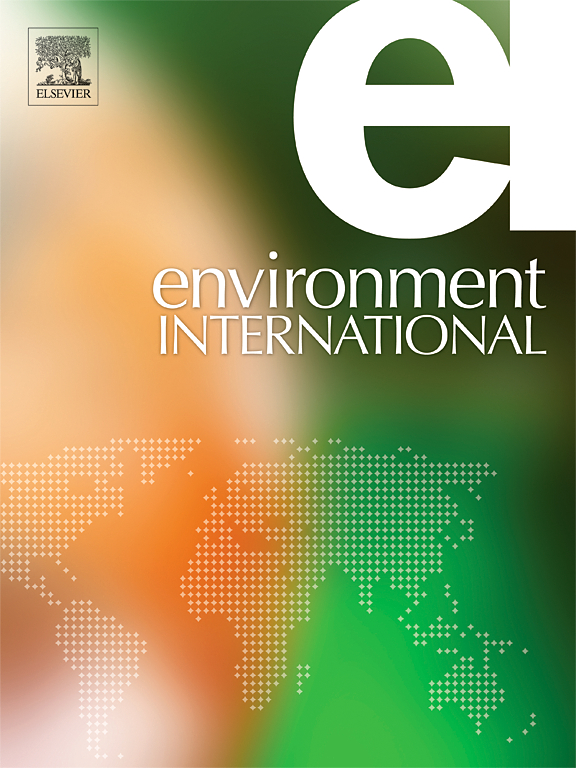How to safeguard soil health against silver nanoparticles through a microbial functional gene-based approach?
IF 10.3
1区 环境科学与生态学
Q1 ENVIRONMENTAL SCIENCES
引用次数: 0
Abstract
Silver nanoparticles (AgNPs), a major anthropogenic stressor, can threaten soil health by disrupting vital microbial processes critical to maintaining key soil functions such as nutrient cycling, organic matter decomposition, and soil structure formation. Their safe use demands proactive strategies to preserve soils, a globally essential and non-renewable resource that acts as the ultimate sink for nanoparticles released into ecosystems. As functionally critical components of soil ecosystems, microorganisms warrant central consideration in developing nanotoxicity mitigation strategies. This review establishes a framework for soil health protection through systematic examination of (a) AgNPs-mediated ecotoxicological impacts on soil ecosystems, (b) microbial community tolerance thresholds, and (c) ecosystem functions most vulnerable to AgNPs exposure. Through bibliometric analysis of 61 studies, we synthesized comprehensive data on AgNPs-tolerant/sensitive microbial taxa and functional genes, while highlighting critical research gaps and priority research area. Our assessment identifies the following key challenges in predicting AgNPs ecotoxicity in soil systems: (1) a wide toxicity dose–response range, with significant effects observed even at environmentally relevant concentrations (≤1.0 mg/kg), (2) high microbial taxonomic heterogeneity complicating targeted identification, as most taxa remain unculturable, uncharacterized, or classifiable only at higher taxonomic ranks, and (3) limited knowledge of soil-AgNPs-environment interactions hindering identification of critical factors controlling AgNPs toxicity in soils. We then demonstrate how functional gene analysis can improve toxicity prediction accuracy and identify compromised soil processes. This functional genomics approach outperforms taxonomic characterization in predicting AgNPs impacts on soil health by directly quantifying disturbances to critical ecosystem processes. This framework will guide future research in predicting AgNPs’ impacts on soil microbial functionality and overall soil health, while offering a broadly applicable approach to assess toxicity for other emerging anthropogenic stressors, including engineered nanomaterials, pesticides, microplastics, and other soil contaminants.


如何通过基于微生物功能基因的方法保护土壤健康免受银纳米颗粒的侵害
银纳米颗粒(AgNPs)是一种主要的人为压力源,它可以通过破坏对维持关键土壤功能(如养分循环、有机质分解和土壤结构形成)至关重要的微生物过程来威胁土壤健康。它们的安全使用需要积极主动的策略来保护土壤,土壤是全球必不可少的不可再生资源,是释放到生态系统中的纳米颗粒的最终汇。微生物作为土壤生态系统中功能关键的组成部分,在制定纳米毒性缓解战略时需要重点考虑。本综述通过系统检查(a) AgNPs介导的土壤生态系统生态毒理学影响,(b)微生物群落耐受阈值,以及(c)最易受AgNPs暴露影响的生态系统功能,建立了土壤健康保护框架。通过对61篇研究的文献计量学分析,我们综合了agnps耐/敏感微生物类群和功能基因的全面数据,同时突出了关键的研究空白和重点研究领域。我们的评估确定了预测AgNPs在土壤系统中的生态毒性的以下关键挑战:(1)毒性剂量反应范围广,即使在环境相关浓度(≤1.0 mg/kg)下也能观察到显著的影响;(2)微生物分类学的高度异质性使目标鉴定复杂化,因为大多数分类群仍然无法培养,无法表征或只能在较高的分类等级上分类;(3)土壤-AgNPs-环境相互作用的知识有限,阻碍了控制AgNPs在土壤中毒性的关键因素的鉴定。然后,我们展示了功能基因分析如何提高毒性预测的准确性并识别受损的土壤过程。这种功能基因组学方法通过直接量化对关键生态系统过程的干扰,在预测AgNPs对土壤健康的影响方面优于分类学表征。该框架将指导未来的研究,预测AgNPs对土壤微生物功能和整体土壤健康的影响,同时提供一种广泛适用的方法来评估其他新兴的人为压力源的毒性,包括工程纳米材料、农药、微塑料和其他土壤污染物。
本文章由计算机程序翻译,如有差异,请以英文原文为准。
求助全文
约1分钟内获得全文
求助全文
来源期刊

Environment International
环境科学-环境科学
CiteScore
21.90
自引率
3.40%
发文量
734
审稿时长
2.8 months
期刊介绍:
Environmental Health publishes manuscripts focusing on critical aspects of environmental and occupational medicine, including studies in toxicology and epidemiology, to illuminate the human health implications of exposure to environmental hazards. The journal adopts an open-access model and practices open peer review.
It caters to scientists and practitioners across all environmental science domains, directly or indirectly impacting human health and well-being. With a commitment to enhancing the prevention of environmentally-related health risks, Environmental Health serves as a public health journal for the community and scientists engaged in matters of public health significance concerning the environment.
 求助内容:
求助内容: 应助结果提醒方式:
应助结果提醒方式:


